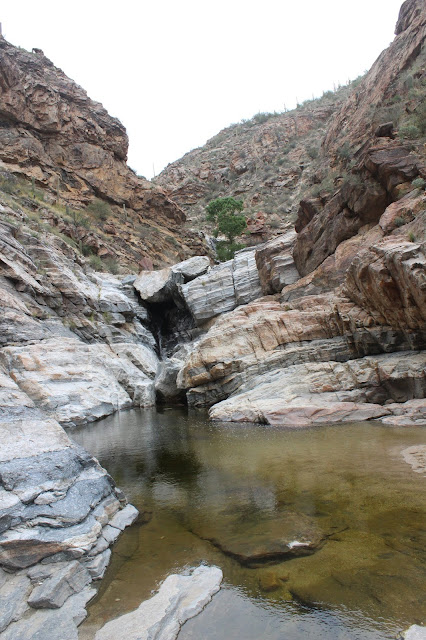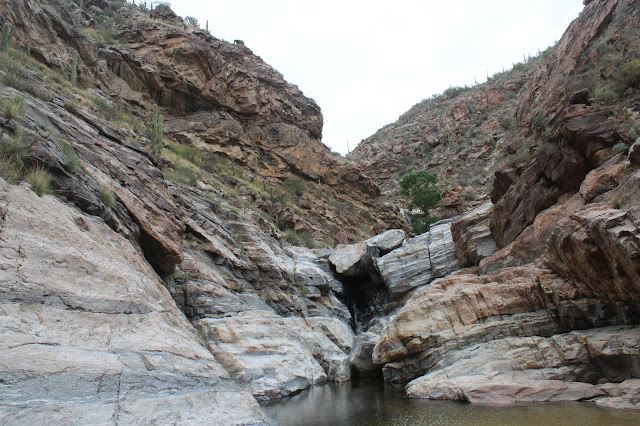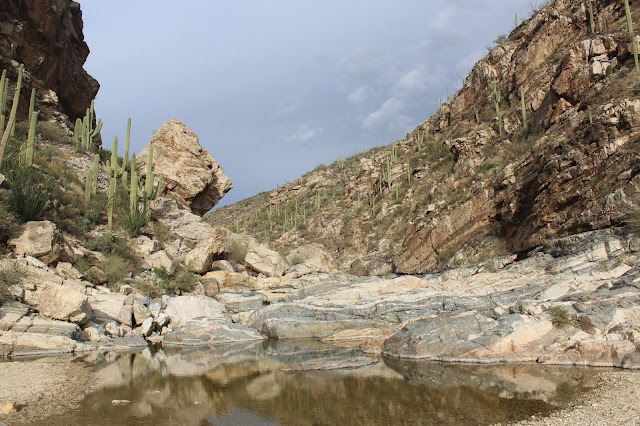Part 10 - Tanque Verde Falls.
Not sure where to start with this place. In true Arizona fashion, there is so much to do here, that it really is hard to cover it all.
Redington Pass seems like a good starting point since Tanque Verde Falls is just a small part of that larger area. Redington is a passage between the Catalina and Rincon Mountains, containing many miles of off-road trails maintained by the Tucson Rough Riders. So, I would like to start by thanking them for all of their efforts and by linking their web-page below:
Website: Tucson Rough Riders
Here is another link that may be helpful to those planning an off-road trip here.
Website: Rider Planet on Redington Pass
In addition to Off-Highway Vehicle trails, there are several hiking trails that cross through this area as well. The most well known is the Arizona Trail. It passes from Italian Trap, through Redington, and into Molino Basin before ascending the Catalina Mountains. Redington is a huge place and we really haven't explored much of it so far, so lets get on to talking about Tanque Verde Falls where the best Summer activity awaits...Swimming!!!
This drive can be tough for people with a fear of heights, there are no guardrails, and it is narrow when oncoming traffic is present. Parking for Tanque Verde Falls can be found on Redington Rd. Shortly after the blacktop turns to dirt, there will be a dirt lot on the left hand side. If you hit the off road vehicle staging area, you have went too far.
Warning: This area is very popular with nudists. In vehicles, on trails, and in the water. You have been warned!!!
The falls can be a very dangerous place during monsoon season, so another warning is due. Please check the weather before hiking into the canyon, as several people have been swept away and killed during flash floods. Read the sign below. Know it. Live it.
 |
| Warning sign on the descent from Redington to Tanque Verde Creek. |
The trail begins across the road from the parking lot, and the sign above makes for a good landmark, before starting the switchbacks down into the canyon. Once the canyon floor becomes visible, you can get a good indication if the falls will have water or not. This is a good sign:
 |
| A view from the descent into the canyon, looking upstream. |
 |
| Looking down at Tanque Verde Creek from the trail on the ridge above. |
Small waterfalls like this one are common when water is present, and they make negotiating the climb a little more challenging. There really isn't a trail in the canyon, its just boulder hopping, which is why we love it so much.
 |
| A view of one of the many pools on the climb up the canyon. |
 |
| Closer shot of the same pool. |
Our favorite view of the canyon, is looking downstream at 'The Rock'. No, not Dwayne Johnson, this rock:
 |
| 'The Rock' A big, square one. Not the wrestler. |
I believe there are about 4 or 5 bends in the canyon before coming to the first set of falls, which is around 30 feet high. This picture was from a dry January day, and as you can see, there are no falls. Normally, the water would flow off the gray stone above, and down to the pool.
 |
| Lower Tanque Verde Falls. No falls, just a pool. |
On our first trip, when the falls were dry, we climbed partially to the top of the 30 foot drop and were stopped on a ledge. We debated climbing up to see the upper falls, but the rest of the climb looked kind of sketchy. We sat down on the ledge and had lunch while we talked about finishing the climb. Still undecided, we stood up to look at handholds again when we noticed something. We had been sitting next to what looked like several small puddles of dried blood. We decided against finishing the climb, especially since there was a good chance those falls were dry too. On the way out, we ran into someone who asked us if we saw the guy get airlifted out yesterday. Shit! Now we know where that blood came from. Undaunted, we swore we would return to get to see water in both sets of falls.
Fast forward to March, and we had enough snowmelt/showers to keep the water flowing in the creek, so we knew the falls would be going strong. We boulder hopped our way over the creek, taking shoes off once or twice, and made it back to the base of the first falls. We really did not want to risk that climb where we saw the blood...but now what??? Luckily, we ran into other hikers who showed us a less dangerous climb that bypassed the first set of falls.
Looking down on this secluded, ecological gem from the trail above was like being in some strange storybook-land. There were the falls, roaring in the distance, with a single tree that managed to root-down through all of the flooding and erosion. There were people here, not many, and none of them naked. Whew.
 |
| Stranger Danger!!! |
We explored, relaxed by the water, and took some pictures before leaving. I even got Jen to look at the camera for one.
 |
| Pretty girl on a secluded sandy beach next to a waterfall. I love Arizona!!! |
Below: Our video of Lower Tanque Verde Falls.
Below: Our video of Upper Tanque Verde Falls.
We loved Tanque Verde Falls so much, that we forced our friend who is scared of heights to drive up Redington for a hike with us. I met Ginni through the lab I worked at, she was with the same staffing agency, and was also traveling in an RV with her family. Her husband David, son Micah, and their two doggos (Jake and Bella) went with us.
Here are some pics from that trip in May of 2018, before we both went on to other assignments.
 |
| Ginni, David, Micah, doggies...and other visitors. |
 |
| Ginni and Jenny. Was Jenny standing on a rock or was Ginni crouching? |
 |
| Such a fun trip. We miss you guys!!! |
 |
| Micah! |
 |
| A small waterfall at the very beginning of the hike up to the real falls. |
 |
| One more 'Rock' for the road. |
Maybe I'm just jealous because I cant even skinny dip at night without getting a sunburn. Guilty of being Irish. Right then! On to the next adventure!!!
Previous Entry:
Part 9B - Mt Wrightson Wilderness Area.
Stay tuned for our next article about our road trip home. It will be posting on Monday June 3rd.














































